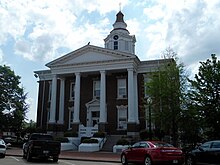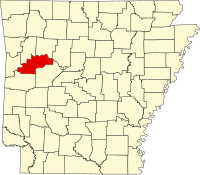Lucas, Arkansas
| Logan County, Arkansas | |
|---|---|

Logan County Courthouse, Paris
|
|
 Location in the U.S. state of Arkansas |
|
 Arkansas's location in the U.S. |
|
| Founded | March 22, 1871 |
| Named for | James Logan |
| Seat |
Paris (northern district); Booneville (southern district) |
| Largest city | Booneville |
| Area | |
| • Total | 732 sq mi (1,896 km2) |
| • Land | 708 sq mi (1,834 km2) |
| • Water | 23 sq mi (60 km2), 3.2% |
| Population (est.) | |
| • (2015) | 21,714 |
| • Density | 32/sq mi (12/km²) |
| Congressional district | 4th |
| Time zone | Central: UTC-6/-5 |
Logan County (formerly Sarber County) is a county located in the U.S. state of Arkansas. As of the 2010 census, the population was 22,353. There are two county seats: Booneville and Paris.
The Arkansas General Assembly defined the state's 64th county on March 22, 1871, and named it Sarber County for John N. Sarber, the Republican state senator from Yell County who had introduced the resolution. The senator was viewed as a carpetbagger, and after the Reconstruction Era state government was replaced the county was renamed for James Logan, an early settler in the area, on December 14, 1875.
According to the U.S. Census Bureau, the county has a total area of 732 square miles (1,900 km2), of which 708 square miles (1,830 km2) is land and 23 square miles (60 km2) (3.2%) is water. The highest natural point in Arkansas, Magazine Mountain at 2,753 feet (839 m), is located in Logan County.
As of the 2000 United States Census, there were 22,486 people, 8,693 households, and 6,302 families residing in the county. The population density was 32 people per square mile (12/km²). There were 9,942 housing units at an average density of 14 per square mile (5/km²). The racial makeup of the county was 96.46% White, 1.05% Black or African American, 0.65% Native American, 0.15% Asian, 0.02% Pacific Islander, 0.39% from other races, and 1.28% from two or more races. 1.21% of the population were Hispanic or Latino of any race.
...
Wikipedia
